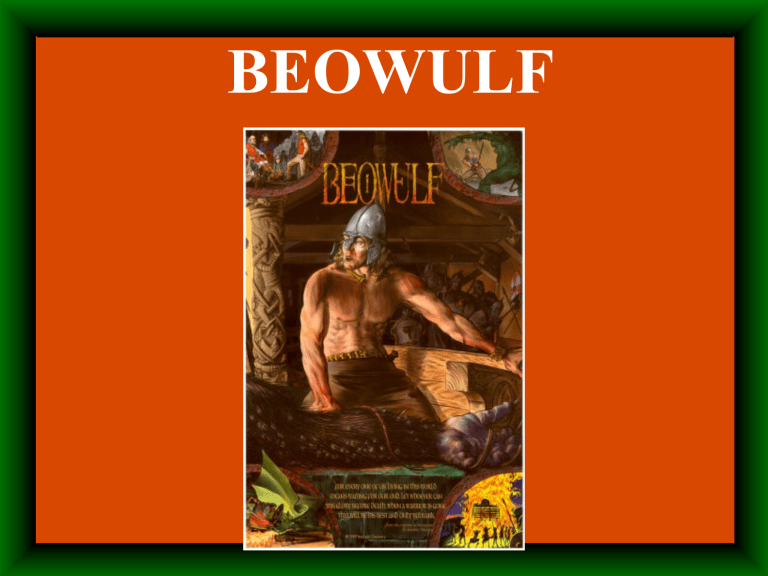
BEOWULF
Anglo-Saxon Period
• The Anglo-Saxon period is the earliest recorded time period in English history.
Anglo-Saxon Period
• The Anglo-Saxon period ranges from 449-1066.
• It ends with the Battle of Hastings where the French, under the leadership of William the
Conqueror invaded England.
Anglo-Saxon Literature
• Few people read in this period
• Oral tradition – was performed and/or sung by a
Bard (Scop) from memory in Old English
• This is why there are often several versions of the same story.
• Scops – poet/minstrels
• Authors were unknown
THE STORY OF BEOWULF
• Beowulf marks the beginning of English literature
• Beowulf is one of the earliest known pieces of literature known in the English language; written in Old English
Contains specific Motifs
• Motifs – a motif is a recurring theme or image in a work of literature
• Biblical and Christian Allusions
• Pagan Customs
• Social Customs
• Traits of the Warrior
• Beowulf Boasts
• The story of Beowulf wasn ’ t written down until about 700 AD by “ The
Beowulf Poet ” who is unknown. He wrote down the poem which for many years had been only sung or spoken.
• Scholars believe “ The Beowulf Poet ” was most likely a Christian monk, thus adding a
Christian perspective.
There is only one original Beowulf manuscript existing today. It is in the British History Museum in London.
BEOWULF is an EPIC poem.
• Epic – a long, narrative poem that relates the great deeds of a largerthan-life hero who embodies the values of a particular society.
Examples of other EPICS are…
• Greek “ Illiad ” and
“ Odyssey ” – Homer
The Hobbit and Lord of the Rings – Tolkien
And of course there ’ s
the EPIC HERO!!!!
• EPIC HERO – must undertake a quest to achieve something of tremendous value to himself and his society
SUMMARY OF EPIC
FEATURES :
• A long narrative poem
• Larger than life hero; often with superhuman characteristics
• Concerns eternal human problems like the struggle between good and evil
• Presented in a serious manner using elevated (poetic) language
• Hero represents widespread national, cultural, or religious values
This EPIC poem of BEOWULF is often divided into 3 sections; it is about Beowulf ’ s 3 epic battles w/ evil.
…the Battle with
Grendel
• (Grendel represents evil)
…the Battle with Grendel ’ s
Mother
(She also represents evil.)
…the Battle with the Dragon
(It not only represents evil but also greed.)
Just in case you wanted to know,
Beowulf himself represents good:
• loyalty
• valor
• selflessness
• sense of justice
Beowulf : Where does it take place?
• Geatland and
Denmark
(Modern Denmark
and Sweden)
Map of Baltic Region of Scandinavia and the Viking Invasions (700 800)
Note
:
None of the action takes place in
England!!!
The Scary, Horror Movie
“ Where ”
More specifically…
Beowulf takes place in a “ once upon a time world ” which taps into “ three archetypal sites of fear.
”
1. The barricaded night house /
Mead Hall (Grendel)
2. The infested underwater lair
(Grendel ’ s Mother)
The Reptile-taunted rocks of a wilderness and cave (Fire
Breathing Dragon)
Which may mean more to your generation?
In bed on a stormy night when we are alone in the house (where we should feel safe).
A murky lake or a beach where
Jaws takes place.
The dark recesses of the earth: a cave, or even your own dark basement!!!
WHY?
Why do we read Beowulf ?
• It’s a very creative, imaginative, poetic masterpiece.
• It gives us insight into the origins of the
British people, the culture, who, through seafaring conquests, founded the world we currently live in.
• It gives us insight into the origins of our language.
Why do we read it?
• It gives us insight into all people everywhere and throughout time (time, birth, death, fame/success/glory, honor, friendship, conflict, home, country, adventure, spirituality – all of these things transcend English literature and matter to all people).
• It’s challenging and we love a good challenge!!!
Why do we read it?
• It’s scary and gets us to think about our own worst fears
• It’s a VERY important piece of literature historically. (This is the
“ because we have to ” reason!!)
Characteristic features of
Anglo-Saxon Literature
• Alliteration
• Kennings
• Caesura
Alliteration
•
The repetition
of beginning
consonant sounds
in lines of poetry
Kenning
• Kenning – a metaphorical phrase used to
replace a concrete noun
• Ex: sea = whale ’ s home
• Ex: battle = spear play
• It is like a mini-riddle
Caesura
• a natural pause in the middle of a line of poetry.
• Two-part line in which each line is separated by a pause or break in the middle of the line; each part generally has two strong beats.
• (Put simply, it is a dramatic pause in the middle of a line.)
Caesura example:
Then the Scylding warrior savage and grim,
Seized the ring-hilt and swung the sword
Struck with fury despairing of life
Thrust at the throat broke through the bone rings:
The stout blade stabbed through her fated flesh.




![Beowulf ̯ wʊlf] e](http://s2.studylib.net/store/data/015349846_1-6394969ef9bb6c6fd1c7317de673118f-300x300.png)
